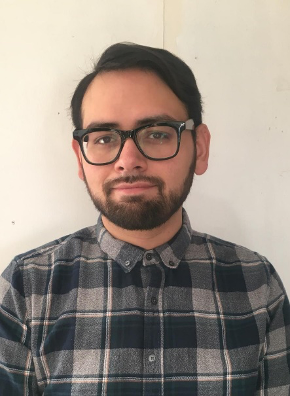
?Buenos días! We are Alisha Garcia Flores, Vianney Leon, and Matthew Silva — representing an internal evaluation and data team at Enlace Chicago in the Little Village community, Chicago, Illinois. Enlace Chicago is a community-based nonprofit that strives to build the capacity of Little Village stakeholders to confront systemic inequities and social injustices. We organize, convene stakeholders, and provide programs and services in the areas of health, immigration, education, and violence prevention. Our community is a highly dense port-of-entry for Mexican immigrants in the Midwest with a population of nearly 75,000 residents, which are 84% Latino, 39% foreign-born, and 29% non-citizen (ACS, 2017).

In 2018, Enlace began building an evaluation team as the organization experienced rapid growth in staffing and initiatives. Enlace values relationships, collaboration, and a deep respect of and partnership with the community.
When we began, we realized staff had more often encountered evaluation in a negative context, making it feel ‘high stakes’ and not representative of the community. It took time to gain a sense of how staff viewed evaluation and what types of support and structures were needed. Evaluating complex initiatives has meant developing an approach that is flexible, iterative, and engaging of diverse stakeholders. We’ve tried to ensure staff are highly engaged in defining our culture around evaluation.

How can internal evaluators create a culture of collaboration and strive for high engagement in evaluation?
Lessons learned:
- Embed yourself as a learner. Building personal relationships with staff to know us as individuals has been crucial. Learning about how the work is done, and the history of the work from staff, partners, and community planning efforts. In 2018, we conducted a staff needs assessment to help define our roles, work, and priorities as internal evaluators. Additionally, we strive to build trusting relationships with staff and partners to continue learning how our team can support the direct-service and initiatives.
- Embed yourself as a team member. Being present. Our evaluation team attends departmental meetings, partner collaborative tables, engages in advocacy efforts, and community events. Staying informed of staff needs, capacities, and current priorities helps us determine how and when to engage staff in evaluation efforts. As we sustain our presence, we have become trusted assets to the “team”, which has led to stronger evaluation buy-in.
- Create platforms for engagement in defining evaluation, We created a Continuous Quality Improvement (CQI) committee with staff representation across departments to help us continually define evaluation culture, terms, practices, showcase examples, and help direct priorities and projects. Our evaluation team members are also engaged in monthly all-staff meetings, departmental CQI meetings, and leadership meetings to discuss evaluation.
- Elevate CQI by learning from the data ‘in-time’. Some of the best engagement opportunities have come from the development and refinement of data collection tools, visual models, and collaborative data interpretation. Host data ‘parties’ to celebrate, learn, and identify areas of growth collaboratively.
The American Evaluation Association is celebrating Latinx Responsive Evaluation Discourse TIG Week. The contributions all this week to aea365 come from LA RED Topical Interest Group members. Do you have questions, concerns, kudos, or content to extend this aea365 contribution? Please add them in the comments section for this post on the aea365 webpage so that we may enrich our community of practice. Would you like to submit an aea365 Tip? Please send a note of interest to aea365@eval.org. aea365 is sponsored by the American Evaluation Association and provides a Tip-a-Day by and for evaluators.

Hola Ms. Garcia, Ms. Leon and Mr. Silva,
Thank you for your thoughtful article, which highlighted for me the importance of collaboration and engagement in evaluation.
As a student in a “Program Inquiry and Evaluation” course, I have learned about evaluators’ various roles, including those beyond the immediate design and implementation of an evaluation and its results. However, I have to admit that, before this course, I had not considered the importance of “relationship building” for evaluators, thus ignoring the complex social dynamics in which evaluators are placed. Nonetheless, as I progress through my course, I have gained new knowledge and perspective. Your article helped me frame this newly acquired knowledge in a practical sense, exemplifying not only “why” but also “how” solid relationships and meaningful interactions and dialogue between evaluators and other staff members and stakeholders create an environment that fosters cooperation inquiry, evaluation and implementation.
As I reflected on your article, I was also able to draw parallels between your proposed “lessons learned” and my role as a kindergarten teacher in a public school with various needs. Embedding oneself as a learner and team member in our organizations resonated with my classroom and school practice and helped me better understand the interconnectedness between evaluators and the rest of the staff to reach a program’s goals. As I connect with the families of my students, highlighting the importance of working together as a team, your article highlights how evaluators need to do the same to “become trusted assets to the ‘team.'” As a result, in both instances, such relationships support “buy-in” and facilitate collaboration and success.
You mentioned in your article that the staff had had negative experiences with evaluation. I wonder if you could share what was the very first step you took as the internal evaluators to move away from such perspective to create a culture of collaboration.
Finally, I want to applaud you and your team at Enlace Chicago for the hard work you are doing to support the population in the Little Village Community. As a Mexican immigrant to Canada, I am aware of some of the challenges faced by immigrants and the importance of organizations like yours that aim to improve the conditions of Latinos. Bravo!
Best,
Ana Ramirez